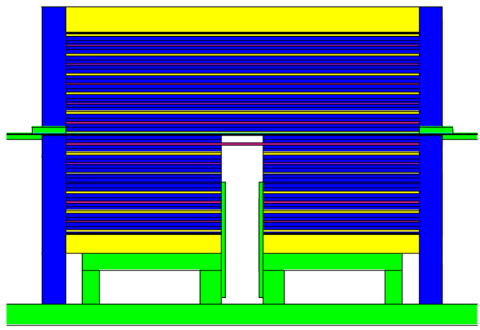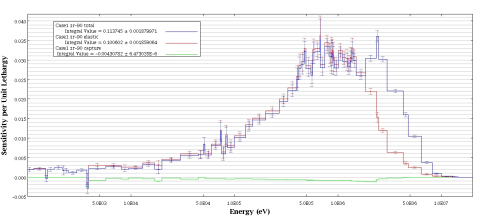An important method in validating neutron cross sections is the execution of critical experiments. In these experiments, changes in the neutron multiplication factor, k, are observed as a function of perturbations in cross sections. Due to the risk of working with radioactive materials, it is important for the design to be analyzed for safety and feasibility. This includes considering factors such as the thermal properties of the materials, their weight, structural integrity of the system, and the feasibility of manufacturing and assembling the parts. Since the final experiment is to be conducted in a closed off and secure location, it will not have any effect on the local environment. Furthermore, the primary purpose is to collect data, therefore no direct societal impacts will come about from this project. The cost of the materials and of operation were also considered and have been calculated to be within a $300,000 budget.
Team: Chad Meece, Gabriella Bruno, Robert Jacob, Mason Yu, Ryan O’Neill
Project Advisor: Prof. Danon

Members of the design group
Project Motivation
Nuclear engineers rely on the accuracy of nuclear data libraries for calculations and simulations utilized in reactor design, criticality safety, medical applications, and many other disciplines. Therefore, the neutron cross section of isotopes relevant to the nuclear industry must be rigorously measured and validated. An additional goal was set to compare multiple Monte Carlo code packages in terms of output and capability. To this end, the project utilized MCNP, OpenMC, and the SCALE code package, with a different sensitivity calculation method in each to ensure accuracy. It is vital for this software to be as accurate as possible due to the infeasibility of physical prototyping in the nuclear field. Consequently, criticial benchmark experiments are necessary to ensure that these codes are correct in their predictions.

Reflected Critical Configuration
Project Description
An important method in validating neutron cross sections is the execution of critical experiments. In these experiments, changes in the neutron multiplication factor, k, are observed as a function of perturbations in cross sections. Due to the risk of working with radioactive materials, it is important for the design to be analyzed for safety and feasibility. This includes considering factors such as the thermal properties of the materials, their weight, structural integrity of the system, and the feasibility of manufacturing and assembling the parts. Since the final experiment is to be conducted in a closed off and secure location, it will not have any effect on the local environment. Furthermore, the primary purpose is to collect data, therefore no direct societal impacts will come about from this project. The cost of the materials and of operation were also considered and have been calculated to be within a $300,000 budget.

Zirconium Sensitivity Plot
Results and Accomplishments
Zirconium was selected as the isotope of interest because of its extensive nuclear applications; these include fuel cladding, moderators and ceramic fuels. Measurements made at the Rensselaer Gaerttner Linear Accelerator Center showed a need for validation of unresolved resonance cross sections in the intermediate to fast energy region. Based on the uncertainties of the current evaluated nuclear data, an energy range of interest was defined from 15 keV to 15 MeV. Three experiments utilizing existing cylindrical highly enriched uranium fuel plates were designed to optimize for sensitivity in three sections of this range. Automated sweeps were carried out across a range of input parameters including moderator, reflector, and zirconium thicknesses. Trials using modified materials and plate stacking order were also carried out. The final optimal experiment had sensitivity peaking at 0.7 MeV, with a total integrated sensitivity of 0.221, which is greater than 5 times above that of past critical experiments.